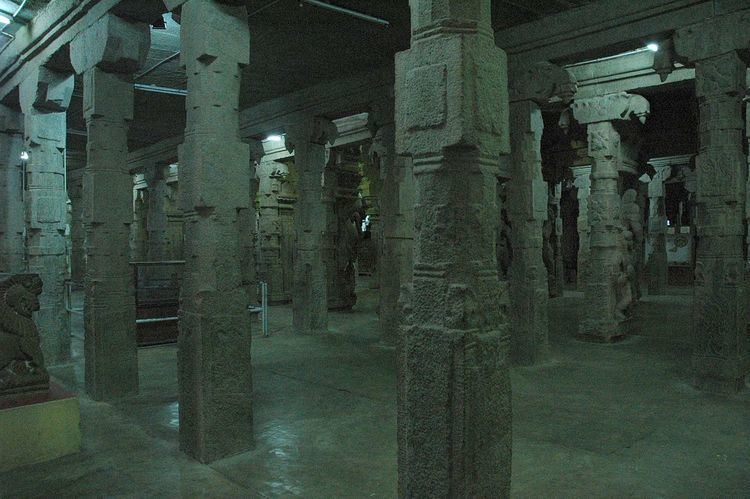 | ||
Ariyanatha Mudaliar was the Vellalar Delavoy (General) and the Chief Minister of the greatest of the Nayaka domains established by the Vijayanagar viceroy and later ruler of Madurai, Viswanatha Nayak (1529–64). He is renowned as the founder of the quasi-feudal organisation of regions called poligar or the palayakkarar system where the regions are divided into palayams (small principalities) and are independently governed by poligars or palayakkarars (petty chiefs).
Contents
Mudaliar enjoyed a cult status in southern Tamil Nadu and became a tutelary patron figure amongst some of the region's cattle-keeping predator groups.
The Aiyaram Kaal Mandapam, or Thousand Pillared Hall, in the famous Meenakshi Temple was constructed by him in 1569. There is a statue of him at the entrance.
Early life
Ariyanatha Mudaliar was born in a Vellala family in Meippedu village, Tondaimandalam (the present day Kanchipuram district). According to a modern descendant, he learned Tamil and Mathematics from a teacher for free and in his spare time mastered the ancient Tamil martial art of Silambam and others like sword fight and wrestling. At the age of 16, he was encouraged to go the court of Krishnadevaraya, the king of Vijayanagara. Ariyanatha soon rose to prominence and became the chief accountant of the Vijayanagara empire.
When the Vijayanagara empire fell, he became the Delavoy (General) and the second-in command to the Vijayanagara viceroy Viswanatha Nayaka of Madurai.
Rise to power
The process of consolidation of the Tamil region under the Vijayanagara empire began at the start of the 16th century. The regions were brought primarily under the control of the Nayaka kingdoms of Madurai, Tanjore and Senji. Though the different Nayaka regions were autonomous, they all acknowledged the sovereignty of the Vijayanagara and its emperor, Krishnadevaraya.
During the process of consolidation, Krishnadevaraya dispatched one of his most successful generals, Nagama Nayaka, on a campaign to punish Virasekhara Chola who had plundered the petty Pandyan regions. The Pandyas were under the protection of the Vijayanagara empire. Having put down Virasekhara, the general Nagama Nayak claimed Madurai for himself. Viswanatha Nayak, the son of Nagama Nayak, was more loyal to the king Krishnadevaraya than to his father. He overthrew his father and handed him over to Krishnadevaraya and as a reward for his loyalty the king appointed Viswanatha Nayaka as the governor of Madurai and other provinces in the neighbouring Tamil country.
Ariyanatha Mudaliar. who led Viswantha Nayak's army. became second-in-command and took power along with the latter in Tirunelveli in southern India. Viswantha Nayak was then succeeded by his son, Krishnappa Nayak, who together with Ariyanatha expanded the Nayak's Madurai kingdom and brought most of the ancient Pandyan territory under its rule.
Palayams or Poligar System
Ariyanatha Mudaliar founded the palayam or poligar system which was widely used to govern the Nayak kingdom during the late 16th century. The system was a quasi-fedual organisation of the country, which was divided into multiple palayams or small provinces and each palayam was ruled by a palayakkarar or a petty chief. The Madurai Nayak kingdom was accordingly divided into 72 palayams and Ariyanatha ruled over them for over 50 years along with Viswanatha and then with his son Krishnappa Nayak.
